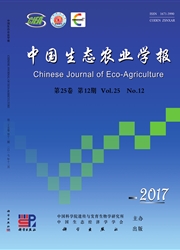

 中文摘要:
中文摘要:
【目的】明确不同氮水平下玉米-大豆套作系统中氮素利用特征。【方法】通过15N标记试验,研究了2种氮水平和3种种植模式下作物氮素吸收、土壤氮素残留与损失及大豆生物固氮量的影响。【结果】套作系统内(IMS)玉米植株总氮吸收量和15N吸收量显著高于玉米单作(MM);IMS内的大豆总氮吸收量低于大豆单作(MS),而IMS内大豆的15N吸收量较MS显著增加,且IMS内大豆的固氮比例及固氮量较MS显著增加。IMS中玉米和大豆对15NH4+总吸收量显著高于15NO3-,且其土壤中的15N残留量15NH4+均低于15NO3-,15N主要残留于0耀40cm土壤中。此外,IMS的15N回收率显著高于各单作,15N损失率低于各单作处理,且IMS的15N回收率15NH4+显著高于15NO3-,15N残留率15NO3-显著高于15NH4+,而15N损失率无显著差异。【结论】与相应的单作相比,玉米-大豆套作显著提高了15N回收率、残留率,降低了15N损失率,增强了大豆生物固氮作用,是一种资源高效、环境友好的可持续农业种植模式。
 英文摘要:
英文摘要:
【Objective】In order to clarify the effects of nitrogen levels on the characteristics of nitrogenutilization in maize-soybean relay intercropping.【Method】15N labeled fertilizer was used to study theeffects of N levels and plant patterns on the crop N uptake,soil N residual,N loss,and soybeanbiological N fixation.【Results】The total N uptake and15N accumulation of maize were significantlyhigher in IMS compared with that of MM.The total N uptake of soybean in IMS was lower than that ofMS,although the15N accumulation of soybean was greater in IMS compared with MS.Compared withMS,the%Ndfa and N fixation of soybean in IMS were significantly increased.The accumulation of15NH4+wassignificantly higher than thatof15NO3-forbothmaize and soybean in IMS.While the15Nresidual of15NH4+was lower than that of15NO3-for both maize and soybean in IMS,the residual of15N was distributed mainly in0耀40cm soil layer.Additionally,the15N recovery ratio of IMS was notably higher than that of thecorresponding monoculture,the15N loss ratio of IMS was lower than that of the corresponding monoculture.In IMS,the15N recovery ratio of15NH4+was remarkably higher than that of15NO3-,and the residual ratio of15NO3-was significantly higher15NH4+.Besides,there were no differences between the loss ratio of15NO3-with15NH4+.【Conclusion】Compared with MS,the15N recovery ratio and residual ratio were remarkablyincreased,and the15N loss ratio was decreased in IMS compared with the corresponding monoculturerespectively,and the biological nitrogen fixation of soybean in IMS was increased.Therefore,the maizesoybeanrelay intercropping was resources efficient,environmentally friendly and sustainable development.
 同期刊论文项目
同期刊论文项目
 同项目期刊论文
同项目期刊论文
 期刊信息
期刊信息
